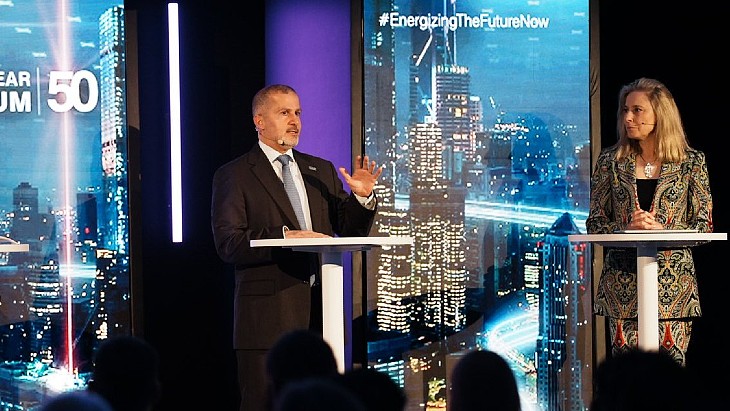Westinghouse Electric Company has informed South Carolina Electric & Gas (SCE&G) that it estimates the additional cost of completing the two VC Summer AP1000 reactors to be about $1.5 billion.
.jpg) |
| The construction site of Summer units 2 and 3, photographed in January 2017 (Image: SCE&G) |
SCE&G parent Scana Corporation told the Public Service Commission (PSC) of South Carolina at an ex parte briefing held on 12 April that Westinghouse had publicly stated the additional costs associated with completing AP1000 projects at Summer and Vogtle, above what it could contractually require the project owners to pay, is about $4 billion. The amount is largely associated with the fixed and firm price option negotiated for the project to build the two AP1000 reactors.
Jimmy Addison, Scana chief financial officer, said Westinghouse had "recently informed" SCE&G that Summer's share of that $4 billion is about $1.5 billion. SCE&G's share, as 55% owner of the plant, would be about $825 million. Those amounts have yet to be validated, he said.
SCE&G had requested the ex parte hearing to inform the PSC of progress at the construction project in Fairfield County, and also to brief the commission on the "status" of Westinghouse, the project's contractor. Westinghouse filed for Chapter 11 bankruptcy on 29 March.
Scana and SCE&G chairman and CEO Kevin Marsh told the PSC that Westinghouse's Chapter 11 bankruptcy filing was a reorganisation filing aiming to isolate Westinghouse's nuclear construction business from its nuclear fuel, components, and services businesses which it intended to continue. He said Scana anticipated any plan to complete the units would include Westinghouse in some capacity, but not in a "leader role" as construction manager. He said the company was in discussions with Fluor - the project's construction manager - and "other potential resources" that could be part of a restructured project to complete the units.
Under an interim agreement reached alongside Westinghouse's bankruptcy filing, SCE&G, together with partner Santee Cooper, are funding continued work on the units during a 30-day period while it evaluates its options. "We may request an extension, if needed, which Westinghouse may agree to grant, or not," Marsh said.
The options being considered are: continuing with the construction of both units; focusing on the construction of one unit, and delaying the construction of the other; continuing with the construction of one and abandoning the other; and abandoning both units. Marsh said "all other things being equal", the company's preferred option would be to complete the units. However, all the options were being given "full and equal consideration on their merits", and no option was being prejudged, he said.
Marsh said Westinghouse had provided access to information concerning the estimated cost to complete the units and its commercial arrangements with Fluor, other contractors, and vendors. The interim agreement had also given Scana direct access to Fluor and other contractors and vendors to discuss commercial and other issues with them.
SCE&G in 2016 chose a fixed price option for the completion of the Summer units under a 2015 amendment to the plant's engineering, procurement and construction (EPC) contract. Addison told the commission that bankruptcy gives Westinghouse the ability to reject or walk away from its fixed price obligations. Should Westinghouse do that, he said, SCE&G and Summer co-owner Santee Cooper would have the right to claim damages from the value of Westinghouse's business and assets. In addition, Westinghouse parent company Toshiba has given SCE&G and Santee Cooper a parental guarantee for Westinghouse's payment obligations under the EPC contract, he said.
"In general, the damages we can collect from Westinghouse and, therefore, Toshiba, are capped at 25% of the payments we have made to Westinghouse at the time it breaches the EPC contract. Given the payments made to date, if the breach occurred today, we would expect the amount of the cap to be approximately $1.7 billion for the total project, or approximately $940 million for SCE&G's 55% share," Addison said.
SCE&G chief operating officer Stephen Byrne said the company was now in the process of determining the feasibility of completing the units, including validating Westinghouse's estimates of additional costs needed to do that. It must also evaluate the costs and activities that would be required to cancel the project, he said.
Since the bankruptcy, Westinghouse had been "generally cooperative and responsive" to SCE&G's requests for information, he said. "We believe that it is in Westinghouse's corporate interests for this project to proceed to a successful conclusion and for Westinghouse to be perceived as fully cooperative in the transition. For that reason, we expect this cooperation to continue as long as these interests are in play," he said. "However, 30 days is an extremely short period of time to conduct our evaluations. An extension of the assessment and evaluation period may be in the project's best interest, and we would hope that it would be possible to obtain such an extension if needed."
Byrne said that under the amended EPC contract, SCE&G has required Westinghouse to escrow intellectual property in the form of software and design information necessary to build and operate the units. "Westinghouse has reported that substantially all of the required intellectual property has now been escrowed," he said.
Byrne also used the ex parte briefing to update the PSC on current activities at the construction site. He said that about 90% of major components - and 85% of all components - were now on site. According to figures supplied by the contractor, the overall project was 63.4% complete as of February 2017.
As well as the Summer units, Westinghouse is building two AP1000s at Vogtle for Southern Company's Georgia Power. Four AP1000 units under construction in China - two each at Sanmen and Haiyang - are not expected to be affected by the bankruptcy filing which only applies to Westinghouse's US operations.
Researched and written
by World Nuclear News





_18570.jpg)
_16159.jpg)
_49205.jpg)





